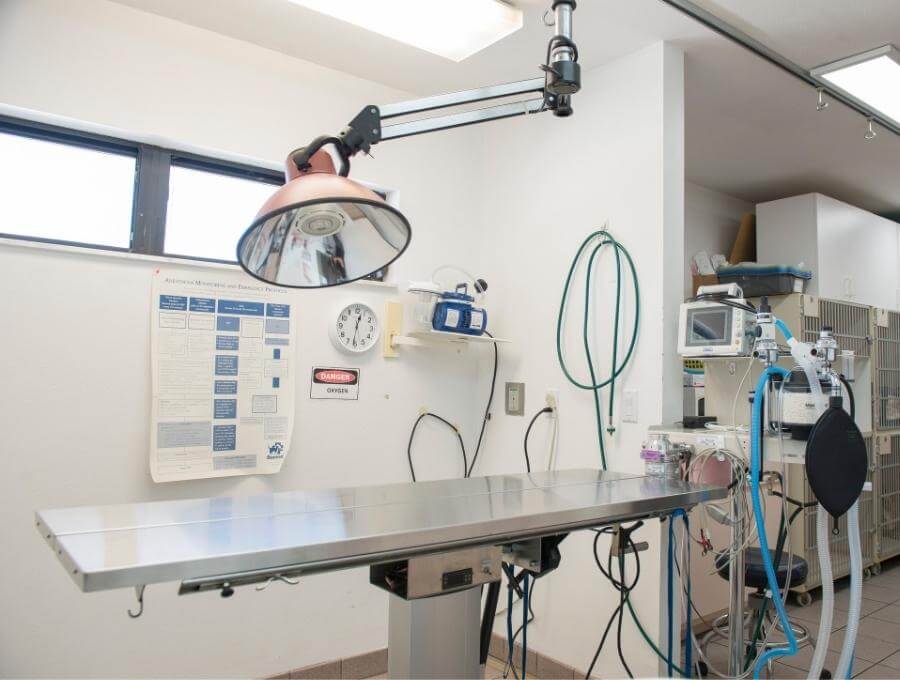Pet Surgery
Learn more about our pet surgery services below.

Pet Surgery in Spring Hill
Pet Surgery
At Animal Medical Clinic of Spring Hill, we understand the decision to allow your pet to undergo surgery is never an easy one. Our team is highly skilled and experienced in performing a wide variety of pet surgeries using modern techniques, cutting-edge equipment and always adhering to the strictest standards of safety and care.
Pre-Operative Blood Work
Routine blood tests are run before anesthesia and surgery to make sure that your pet does not have a disease or illness that would make anesthesia or surgery a significant risk. This lab work is very similar to the “pre-op labs” that your doctor would recommend before you have any procedure performed on yourself.
Hysterectomy
Female dogs will generally go through a heat cycle or estrus every 6 months. The heat cycle may last several days or up to three or four weeks. She may become short-tempered or anxious during this time.
On the other hand, female cats come into heat cycles every three to four weeks during certain times of the year. They may show signs of nervousness, and exhibit unusual behaviors such as rolling on the floor, furtively hiding, or wanting constant attention. They can also become quite vocal.
When your pet is spayed at Animal Medical Clinic of Spring Hill, they will undergo anesthesia with full anesthetic monitoring during the procedure. The pets will be placed in a heated recovery area and monitored closely because they may still be groggy after surgery. A pick-up time will be scheduled with the owner. Patients will go home on pain medications and instructions on strict exercise restrictions. If you have any questions or concerns regarding surgery or would like to schedule surgery, please give us a call for more information.
Castration
In addition, male cats are well-known to mark their territories by spraying odorous urine on furniture, walls, shrubs, etc. Male dogs will also mark their territories. Surgical neutering of male dogs and cats eliminates reproductive behavior and reduces urine odor and the desire to spray. Your dog or cat will continue to have his own unique personality. He will be less likely to roam and will enjoy staying around home more. The surgery removes the testicles. Deciding when is the best time to neuter or castrate your pet is a decision you should discuss with your veterinarian. All neuters are performed under general anesthesia and will proper anesthetic monitoring. The pets will be placed in a heated recovery area and monitored closely because they may still be groggy after surgery. A pick-up time will be scheduled with the owner. Patients will go home on pain medications and instructions on strict exercise restrictions. Cats do not have sutures and dogs will have absorbable sutures, so no follow-up appointment is required unless you have questions or concerns regarding the surgical site.
Laceration Repair
One of the most common surgeries performed in veterinary medicine is a laceration repair. A laceration is a wound produced by the tearing of body tissue. Bites, cuts, and punctures often cause severe damage requiring surgical treatment. Surgical repair is indicated whenever the laceration occurred recently and is large enough to warrant sutures. Wounds have many causes, sizes, and locations. They are usually treated surgically by cleaning and removing the damaged tissue, then closing the wound with sutures. In some cases, drains may be placed in wounds if there is a concern for fluid build-up under the skin. If your pet has a laceration, please give us a call immediately. For this situation, we do not require a referral or previous diagnosis from your primary vet. The longer the time between injury and repair, the more likely the tissues will become infected and healing will be delayed.
We will provide you with detailed instructions for post-operative care. The post-operative care and monitoring component of recovering from a laceration surgery is just as important as the surgery. As the owner, you will need to be attentive to making sure your pet wears a cone around its collar to prevent aggravating and licking the wound.
Cystotomy
We will provide you with detailed instructions for post-operative care. The post-operative care and monitoring component of recovering from Bladder Stone Surgery are just as important as the surgery. As the owner, you will need to be attentive to keeping your pet on the recommended diet and keep the incision site clean and dry, as well as ensure that your pet wears a cone around its collar to prevent aggravating the area. These stones will recur if you do not take preventative measures after surgery. It is highly recommended to make a follow-up appointment with your primary veterinarian to create and implement a preventive plan to decrease the chance of bladder infection.
Growth Removals
Lump removals are intended to remove dangerous or unwanted growths from your pet. The goal is to remove abnormal tissue so it cannot cause problems either by growing too large, damaging surrounding tissue, or spreading to other places inside the body. Please note the recurrence of certain tumors is possible despite appropriate surgical removal. We often recommend sending the removed tissue to our lab so a histopathologist can review and determine if any other action needs to be taken. We can have the lab results sent to your primary veterinarian (with your permission) for review and additional follow-up care to help prevent recurrence or spread of the tumor.
Exploratory Surgery
Gastropexy
Umbilical Hernia Repair
Cryptorchid Surgery
Your dog can be diagnosed with cryptorchidism when either one or both of its testicles have failed to descend into the scrotum. Cryptorchidism is not a painful condition. However, it is important to neuter these dogs to avoid any future health issues. Contact us today to learn more about how to treat cryptorchidism.
